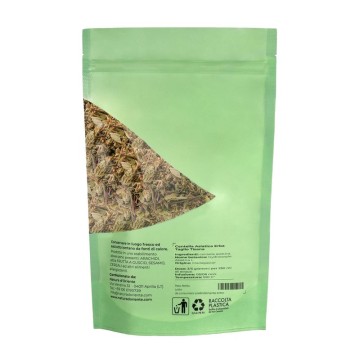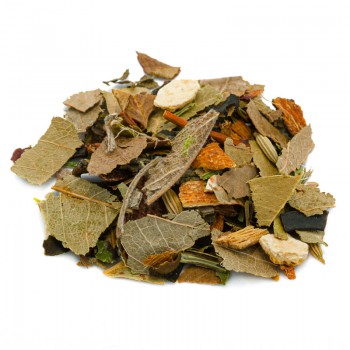Centella asiatica, also known as Gotu Kola , is a medicinal herb known for centuries for its beneficial characteristics on microcirculation, the well-being of the skin and the purification of the organism.
Gotu kola: properties and benefits
Among the health benefits of centella, certainly the best known for those who use it in herbal tea, is its effect on improvement of blood circulation in the legs , and lymphatic circulation.
In particular, centella helps microcirculation, and at the same time relieves the heaviness of the legs due to swelling. This plant, in fact, is able to reduce water retention , which causes swollen legs and ankles.
Those suffering from poor blood circulation can take advantage of the properties of gotu kola, due to the triterpene saponins, contained in the leaves in abundance.
Saponins improve venous circulation by stimulating fibroblasts, the cells responsible for collagen synthesis. This substance is essential for the health of connective tissues and blood vessel walls - as well as having benefits on the skin.
The intake of centella, therefore, creates useful conditions to counteract venous insufficiency and the appearance of capillaries in evidence; moreover, it acts beneficially to relieve cramps, pains in the veins and the appearance of hemorrhoids.
Its vasoprotective action, in addition to toning the vascular walls and promoting circulation, allows a correct venous return to the periphery of the heart, with beneficial effects on the entire cardiovascular system. These characteristics can be a resource if we practice physical activity, restoring energy correctly.
Its optimal characteristics to strengthen the connective tissue and blood vessel walls, it can also have good anti-cellulite effects.
We know that cellulite is caused by an increase in fat cells or a decrease in the integrity of the connective tissue. Fat tends to swell through the connective tissue and constriction of small blood vessels occurs. In this way, you get to the orange peel skin.
Its beneficial action against cellulite is due to the fact that gotu kola can regulate the metabolism of connective tissue cells and improve microcirculation. Its action on the blood vessels allows a strong drainage of liquids, preventing them from stagnating and creating an unsightly swelling.
Centella with its draining action, promotes the purification of the lymphatic system, and the skin appears more toned and uniform.
At the cutaneous level, in fact, Centella has a tradition known as we have seen in the treatment of irritations and wounds. This happens because the triterpenoid compounds (asiaticoside and madecassoside) contained, promote the production of collagen.
The improved vascularization actually facilitates tissue repair both internally and externally.
A practice that accelerates the wound healing process, and helps the beauty of the skin in an anti-aging function.
Thanks to its draining properties, moreover, this plant improves the well-being of the bladder and diuresis.
Origins and History of cultivation
Centella asiatica is a medicinal herb native to India and Madagascar, and has been used for centuries in Ayurvedic, traditional Chinese and Indonesian medicine.
Also referred to as the herb of longevity, for many populations it has been a sort of “panacea” for many diseases. In the past it has been used in herbal teas, decoctions, ointments that are beneficial for different parts of the body and organs.
The active ingredients are found in the leaves, and tradition saw Centella used above all to heal wounds and soothe skin inflammations. It is also known as tiger grass, in fact, because a legend has it that tigers use it to heal their wounds.
It was considered a tonic to improve cognitive functions, with neuro-protective functions, and also used for liver and kidney health.
Even today it is used both as a medicinal herbboth as a vegetable in the kitchen.
Plant and flowers
Centella asiatica is a perennial herbaceous plant native to India and Madagascar, which grows in humid and shady places, typically along waterways and swamps.
It is part of the Apiaceae family, and is also known as Gotu kola and kodavan. The stems are thin, and connect the plants together - Centella is considered a weed.
The white or crimson flowers are born in small groups (umbrellas) near the surface of the ground. The Centella crop matures in about 3 months, and the entire plant is harvested, including the roots.
Being a plant it is aquatic, it is particularly sensitive to water pollutants, and for this reason we often tend to cultivate it in drier soils, watering it regularly.
Nutritional values of Centella asiatica
The benefits of gotu kola are largely due to the saponins (or triterpenoids) contained in the plant.
Saponins include elements such as asiaticoside, asiatic acid, brahmoside, madecassoside and madasian acid. However, the chemical composition of gotu kola also includes vitamins B and C, fatty acids, flavonoids, phytosterols and amino acids.
How to use gotu kola in herbal tea
The infusion of Centella asiatica is obtained from the herb in a herbal tea cut, to be inserted in a cup (250 ml): about 3-5 grams with water at 100 ° C.
Leave to infuse for 5 to 8 minutes, before drinking the draining herbal tea.
Add honey or sugar if desired.
Gotu kola: side effects and contraindications
Rarely the intake in herbal tea can cause allergic skin reactions, but it is still advisable not to take the Centella herbal tea excessively. In high doses it can cause headaches.
Also, it is not recommended during pregnancy because it could cause the uterine muscles to relax. It is best not to use centella even while breastfeeding.











 No reward points for this product.
No reward points for this product.








